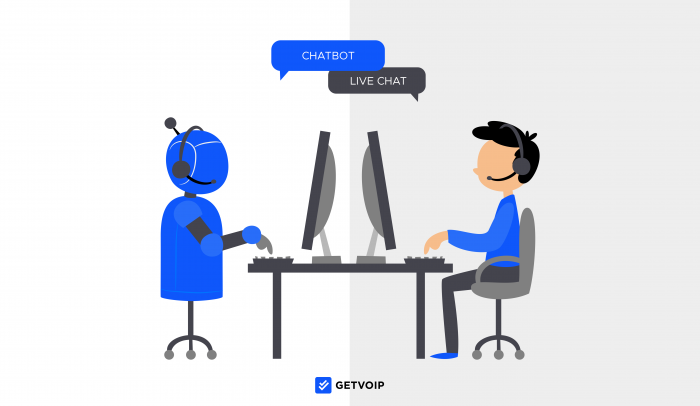In our world of smartphones, electric cars, and space tourism, it’s easy to forget just how much of an impact AI-powered customer chatbots have had on customer service. Chatbots increase agent efficiency, provide speedy answers, and can even make product recommendations.
However, live chat offers a more personalized approach to customer service, making buyers feel more valued and understood.
So, which approach to customer service is right for your business?
We’ll go over the key differences between chatbots vs live chat, what each tool can and cannot do, and the pros and cons of both options.
- Overview
- Detailed Comparison
- Which One Do You Need?
- The Future of Chatbots
- Top Providers
- More Ways To Reduce Support Tickets
Chatbot vs Live Chat: Overview
Live chat agents provide human-to-human service that is especially useful in resolving complicated, multi-step issues, or those requiring strong security. Chatbots, on the other hand, use AI to provide convenient self-service through automated conversation flows: customers can quickly solve simple issues 24/7/365, without having to wait in a queue. When used together, live chat and chatbots provide a well-rounded customer support experience.
The below table provides a quick summary of the key differences between live chat vs chatbots.
| Chatbot | Live Chat | |
| Response Time | Near-instant automated responses | Dependent on agent availability, customers may have to wait for a response or schedule a callback |
| Availability | 24/7/365 availability | Available only during agent working hours |
| Scalability | Scalability from pre-bundled provider plans or individual add-on features | Scalability depends on company's ability to hire more agents |
| Personalization | Some personalization is possible thanks to automation from CRM integrations, but still limited compared to live chat | In addition to personalization from automation, provides a high level of personalization thanks to live agent assistance, searchable internal knowledge database, real-time access to notes from previous interactions, and contact/account info |
| Versatility | Limited to pre-programmed responses | Able to access any information in knowledge databases or source assistance from other agents/supervisors |
| Cost-Effectiveness | More cost-effective (no need to hire additional agents, leaves agents available to help with urgent issues or make more outbound sales calls) | Less cost-effective (may require the hiring of geographically diverse additional agents to provide adequate live chat support) |
| Customer Sentiment | Depends on individual customer preference, but offers instant responses | Depends on individual customer preference, but allows for greater personalization |
Chatbot vs Live Chat: Detailed Comparison
Let’s take a closer look at the seven customer service qualities above to determine whether your business should use chatbots or live chat messaging to meet customer expectations.
Response Time
Response time is the amount of time a customer or prospect has to wait before receiving an answer to their query. Note that “response time” is different from “resolution time,” which means the length of time it takes to completely resolve a customer’s question or issue.
Based on speed and efficiency alone, it’s obvious that chatbots provide a much faster response time and lower hold times than live agent chat.
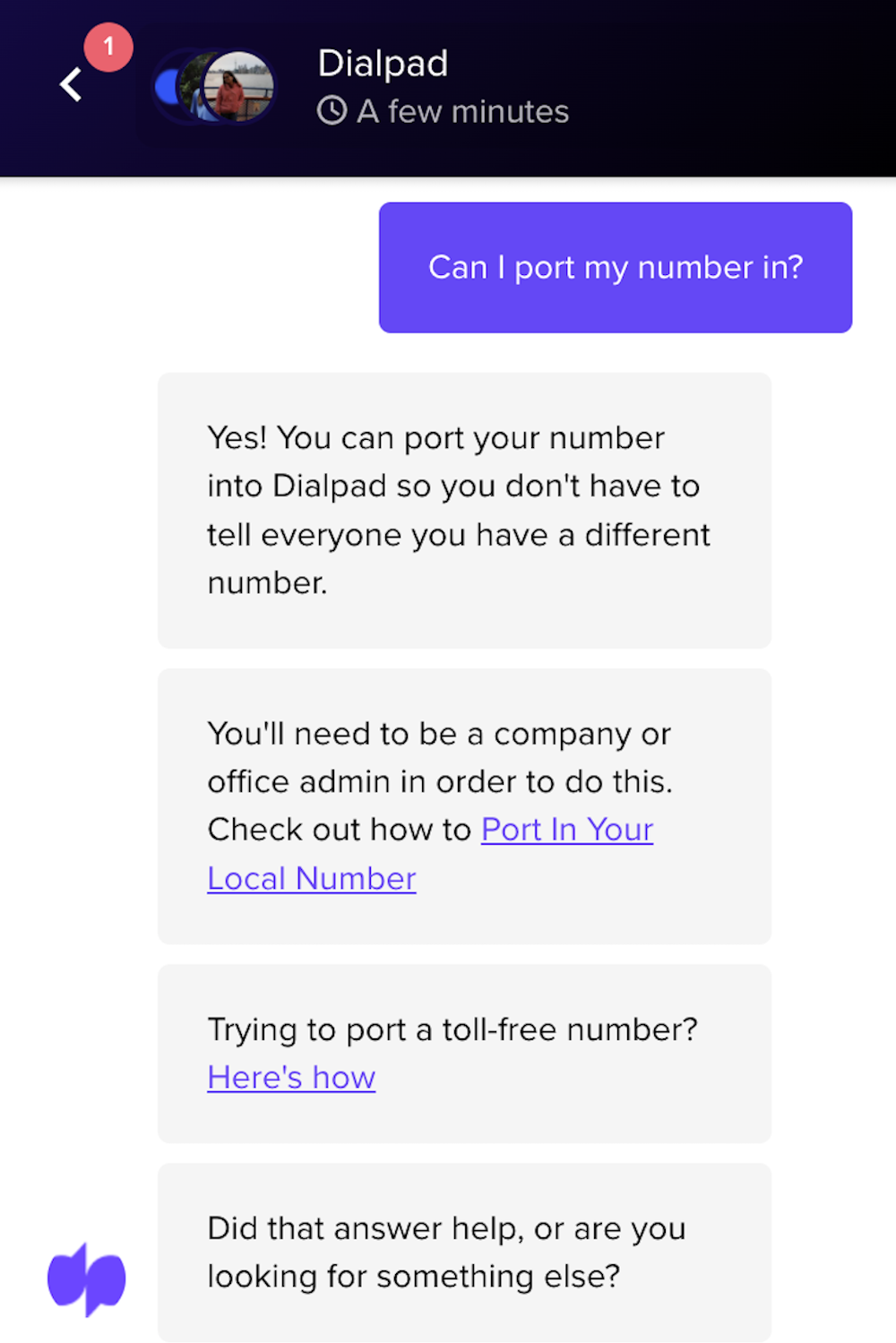
An automated chatbot from Dialpad gave us instant answers to our questions
Because chatbots don’t require a live agent and provide automatic answers based on pre-programmed “trigger words,” they’re always ready for a conversation (albeit, a pre-programmed one.) Plus, they can take on multiple conversations at once, a huge bonus during high-volume periods.
Most chatbots can provide answers just1-5 seconds after the initial query, much faster than the time it takes a representative to connect, recall or search for the answer, then type it up. There’s also the issue of queuing.
Relying solely on human representatives means you could have multiple people waiting in line until the next agent is ready to take their question.
But most of the people in the queue probably have a simple and common question that chatbots could answer in a matter of seconds. Therefore, chatbots are an excellent way to cut the queue volume in half – and increase customer satisfaction as a result.
Long wait times also have a drastic effect on revenue. Research from ifbyphone says that 59% of customers are more likely to buy if they spend less than one minute waiting for a response.
So, in this case, time is literally money.
Winner: Chatbots
Availability
Perhaps the most obvious benefit of chatbots is their 24/7/365 availability.
Unlike live agents, chatbots don’t need to eat, sleep, take sick days, and they even work weekends. This means your customers can get quick answers to simple questions on their own schedules, not according to your office hours.
And even if the chatbot can’t answer a customer query that’s too complex or requires human interaction?
It’s still able to create a case report and ticket number so your representatives can follow up during standard operating hours. This also makes your human teams' workload much more manageable.

Here, someone browsing the Drift Chat website shows their frustration with not being connected to a live agent.
Outside of just providing customer support, the infinite availability of chatbots is a great way to boost sales. Instead of having sales representatives get out of bed at midnight to chat with people browsing your website, chatbots can take a proactive approach to lead management (they don’t need sleep, remember?) No one is expecting chatbots to close deals for you (not yet, anyway.)
However, chatbots can be pre-programmed to engage with customers at specific touchpoints, like when they visit the pricing page or have spent a certain amount of time browsing products. Chatbots can also make product/service recommendations, answer common questions, or even book a demo or appointment with a rep.
Sales-focused chatbots save your agents time by separating uninterested buyers from those who are ready to make a purchase or who want to lead more. Your reps will appreciate no longer having to waste time on prospects that were never really going to close.
Winner: Chatbots
Scalability
Chatbots and other conversational AI advancements have made it a lot easier for companies to scale up without slashing their profit margins. Not having to spend as much time and money on recruiting + training human employees can make a huge difference for growing businesses.
While chatbots can’t handle all the questions themselves, they take enough load off your human agents which means you won’t have to hire as many new recruits nor will you have to make your current teamwork overtime.
A joint survey by Drift, Audience, and MyCleverasked thousands of customers about their top frustrations when interacting with businesses online.
The top four frustrations were:
- Sites are hard to navigate (34%)
- Can’t get answers to simple questions (31%)
- Basic details about a business are hard to find (28%)
- Takes too long to find services (27%)
Chatbots can alleviate most of these issues thanks to features like pre-programmed responses, internal knowledge base page links, or by directing customers to a specific product/service page based on their responses to a series of set questions. . These features let you scale up without compounding the kinds of frustrations that could result in user churn and loss of revenue.
Winner: Chatbots
Personalization
Chatbots already outpace live agent support in many aspects of customer service. However, one unique advantage that we humans have managed to hold onto is the ability to personalize conversations.
A live representative can shift their tone of writing and language based on the emotional state of a customer. If they get an inbound live chat ticket for a prospect interested in the service, then reps can ask and answer the right questions, explain the benefits of core features to that unique company, and convey a sense of excitement in their tone.
Personalization is especially important when a customer is agitated or upset.
Just think about how many times you’ve yelled into the phone at an extensive pre-programmed IVR call menu with automated voice response that doesn’t provide any actionable - let alone relevant - insight.
A lack of personalization makes many customers feel like the company does not value their time or their money, and they’re likely to take their business elsewhere as a result.t.
Chatbots do very little to appease an irate customer, and in most cases, make the situation even worse. A live agent can establish empathy, ensure they’ve clearly understood the problem, find a way to resolve the customer’s issue, and provide an incentive like a discount or refund to keep the customer coming back.
That’s not to say that chatbots can’t be personalized in some ways, though.
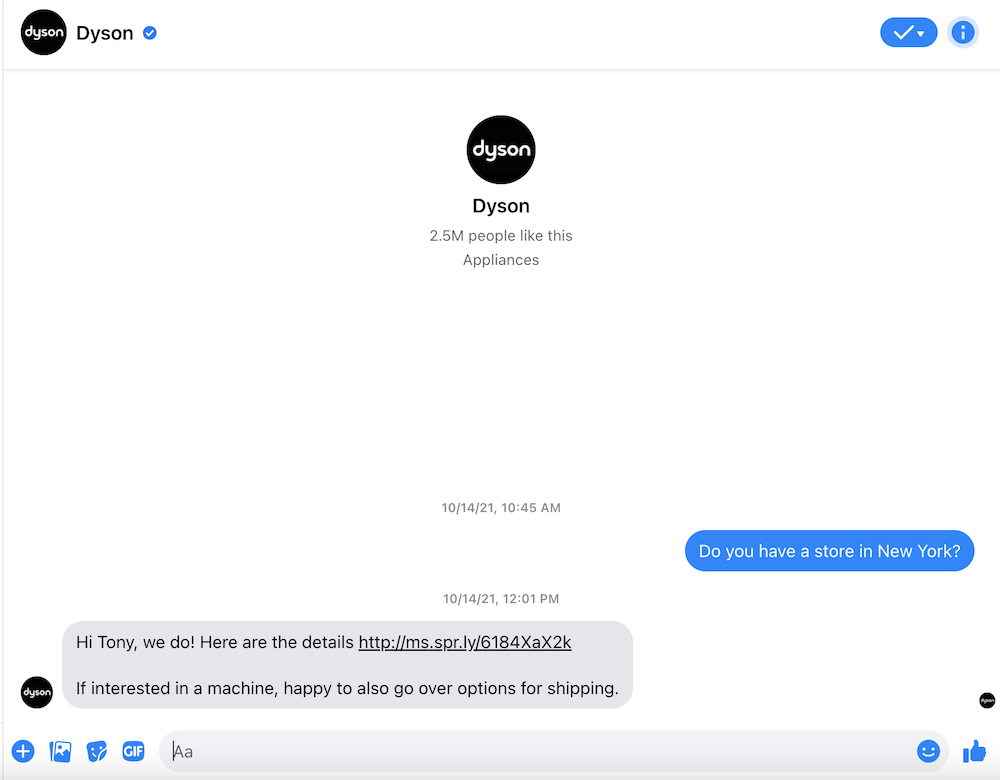
Even a small amount of personalization, like this automated chat from Dyson that calls the customer by their name, makes a difference
Some AI chatbots use data from previous chat interactions or contact information stored in the CRM system to offer somewhat personalized support. However, smart chatbots can also be rather pricey – meaning many companies opt for solutions that don’t store chat data. This lack of access to key data is detrimental to customer satisfaction, especially since it requires the customer to re-enter all their information when starting a new chat.
Winner: Live Agent Chat
Versatility
Chatbots are great at answering repetitive questions like how much a product or service costs, business operating hours, or what number customers should dial to connect with a live agent.
However, they will fall short on questions outside the scope of their pre-programmed keywords and automated responses. Raising issues that are too complex could cause chatbots to give irrelevant answers or get stuck providing the same response.
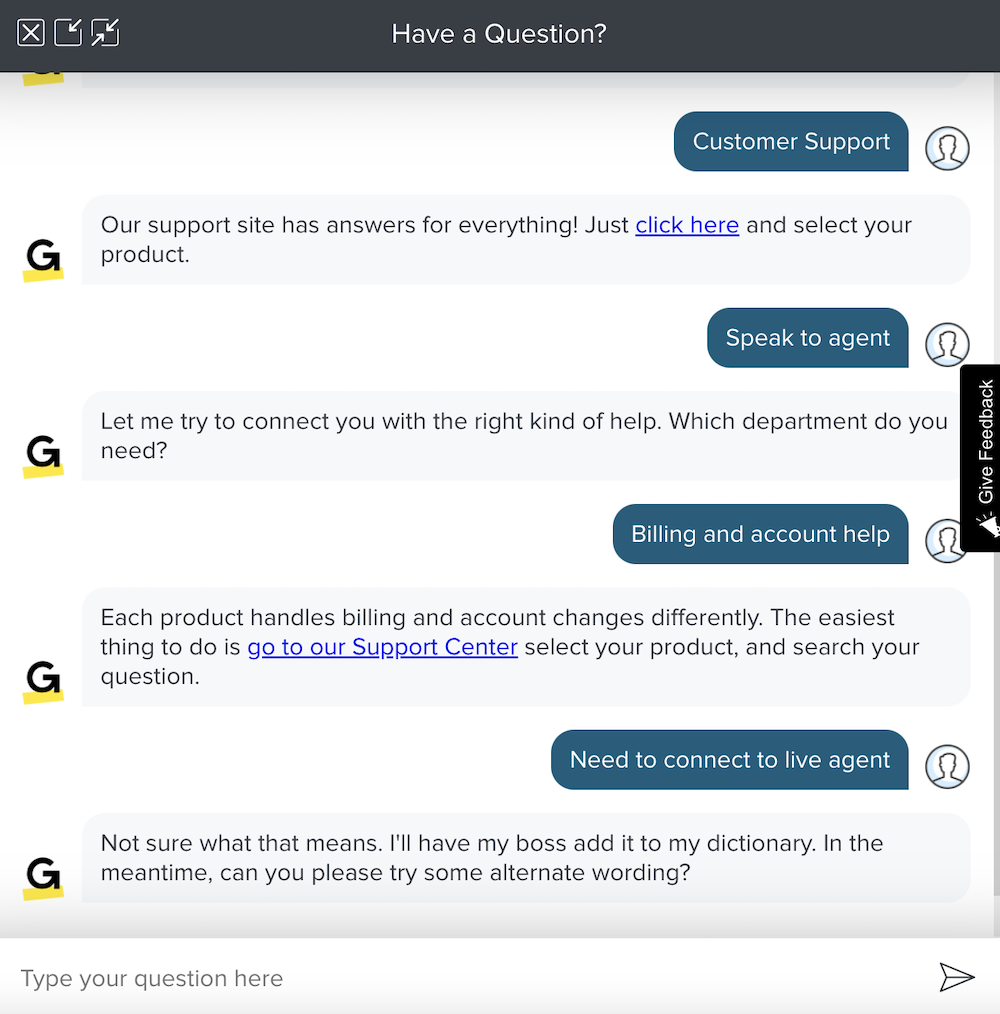
GoToConnect's chatbot was unable to fulfill our request to connect us to a live agent
Spelling and grammar also play a role, but to varying degrees. Simpler chatbots need exact phrases that are spelled correctly, while more advanced solutions like IBM’s Watson have auto-correction capabilities that fix misspellings in customer responses.
That being said, chatbots aren’t as limited as you might think.
Comm100 found that chatbots can handle 59% of all chat interactions. This helps your customer representatives focus all their attention on the remaining 41% — reducing burnout and improving customer satisfaction in the process.
Winner: Live Agent Chat
Cost-Effectiveness
In most cases, the annual cost of a chatbot subscription is cheaper than the salary for a single customer representative.
When you calculate how many team members you’d need to hire as you scale up, chatbots become a much more attractive and viable solution. Beyond purely financial considerations, it also takes a lot more time to find the right candidates for the job than it does to set up a chatbot. You’ll have to go through a pile of resumes, schedule interviews, and implement employee training programs before new team member onboarding is complete.
While it’s true that call center software could increase the productivity of each individual agent to reduce the necessary team size, it likely won’t be enough to bridge the gap between the cost of chatbots and humans. It should also be noted that the subscription cost for call center software will often cost more than a chatbot solution since you’re paying a per-user rate.
In fact, Dr. Daniela Braga, CEO of DefinedCrowd, estimates that chatbots can reduce customer service costs by up to 30%. Excluding operating costs, a Qualtrics XM Institute study found that poor customer service could cost businesses $4.7 trillion in consumer spending.
Not to mention the fact that hiring and training human agents is expensive too. Sharpen found that a 100-agent call center with an industry-standard 45% attrition rate could be spending $1.6 million to $4.8 million every year on employee turnover.
There’s no question, chatbots pay for themselves.
Winner: Chatbots
Customer Sentiment
You may assume customers would rather talk to a human agent than a robot, but that isn’t always the case. In fact, the empirical data tells a different story entirely.
The Harvard Business Review found that 81% of customers try to solve their own problems before reaching out to a live representative.
Furthermore, studies have shown that companies who offered a self-service support option saw their customer retention rates increase by 85%. It’s clear that all customers care about is how long it takes to solve their problem — not who’s solving it.
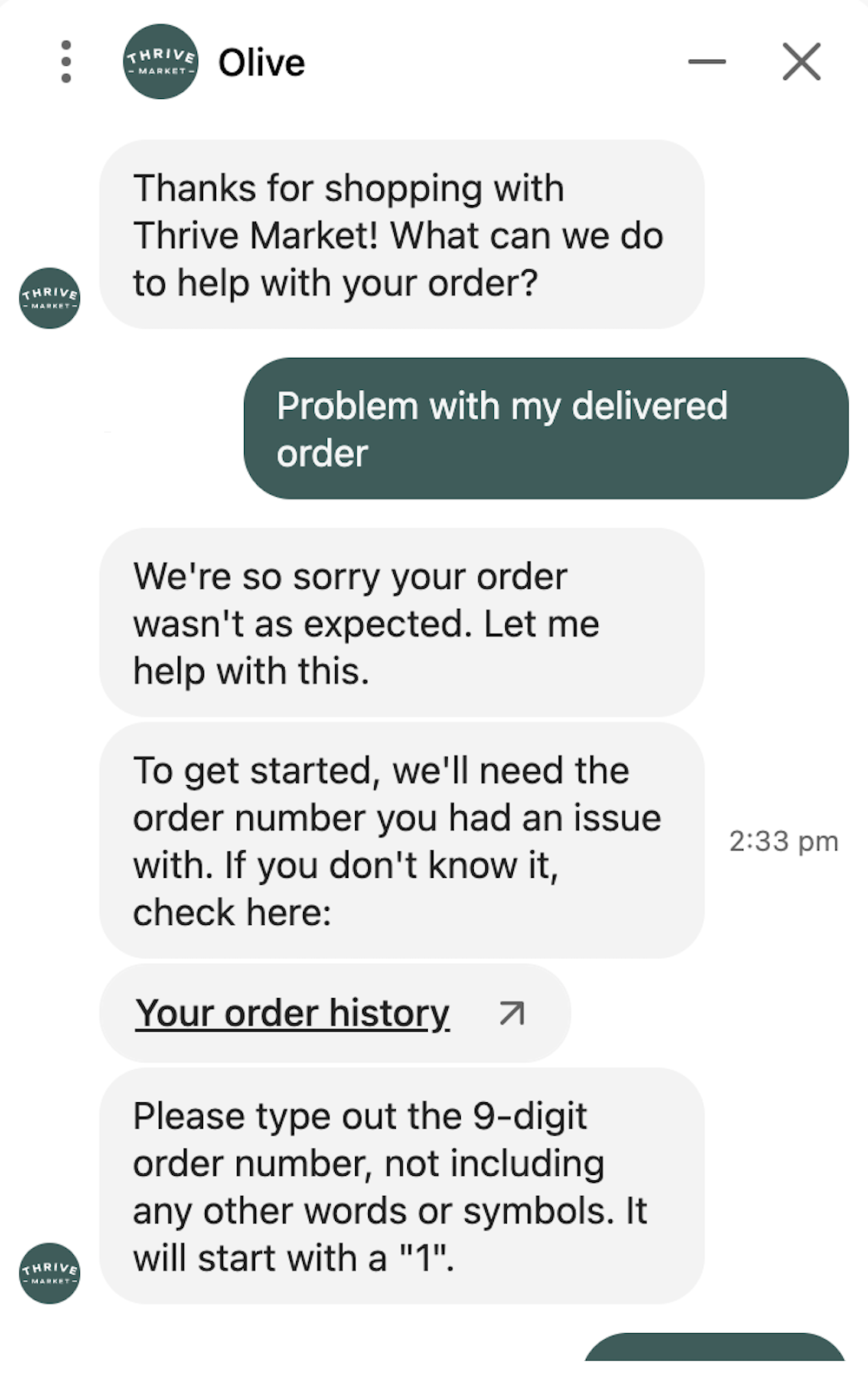
A customer uses grocery company Thrive's self-service chatbot to check on their order
After all, who would choose to wait on hold for 15 minutes if they can just ask a chatbot or go through a knowledge base to solve their problem in half the time? While you should always offer customers the choice to speak to a live representative, you shouldn’t worry that using chatbots could have a negative impact on your brand image.
Winner: Depends On Individual Customer Preferences
Chatbot vs Live Chat: Which One Do You Need?
Still not sure if you need chatbots, live chat, or both?
This section will help you figure it out.
When to Use Chatbots
Most large-scale businesses that serve a nationwide or international audience should implement chatbots in some capacity. While these businesses could hire a 24/7 support team or outsource, the sheer volume of support requests could still leave customers waiting for a response for too long.
Plus, hiring 24/7/365 support teams is significantly more expensive than using a chatbot solution. Chatbots also allow live agents to spend more time helping customers with complicated needs instead of having to rush through endless support requests or spend their valuable time repeating the same basic answers over and over again.
Make sure to factor in the pace at which your business is growing.
If your company is getting thousands of new users every month, then it simply won’t be possible — nor cost-effective — to hire live agents quickly enough to keep pace with customer expectations. The best way to maintain a high level of support without hour-long queue times is to use AI to take out the “low-hanging fruit” tickets.
In other words?
Chatbots are an addition to, not a replacement for, live agent skills and conversation.
When to Use Live Chat
Chatbots are a major breakthrough, but let’s not forget how efficient humans can be, too.
Most experienced support agents can handle 3-4 chats at once while still giving helpful answers and keeping their contact resolution times low.
Startups or smaller businesses with a low daily call volume could probably get by with a single representative (at least, until they decide to scale up.). Local businesses with customers in the same time zone may also be able to handle support through live chat alone.
Most local businesses aren’t expected to offer 24/7 support, and customers will be more willing to wait a bit longer for a response if it means more personalized, quality customer support and service.
Companies working in sectors that frequently handle sensitive information (like finance or healthcare) will need to have live agent support to protect customer privacy and follow industry laws.
The Future of Chatbots
We personally reached out to Chief Marketing Officer at Internxt Mia Naumoska to get her thoughts on how chatbots influence future customer service.
"Artificial Intelligence (AI) is turning customer service on its head. No longer are companies forced to field huge departments with the sole purpose of quick and accurate customer interactions.
Chatbots have advanced so much over the last few years that they can give even the best customer service rep a run for their money. While they may not have that special ‘human touch’ they are an amazing opportunity for smaller companies who may not have the budget or who’d rather invest the time, money, and people back into their product or service."
“Every time a support question comes in, I ask myself ‘how can I reduce this request in the future?’
There are a few things you can try. Tooltips are great because they stay hidden until they’re needed. You could add a single welcome popup that gives a brief overview of the software and welcomes users to the app.
I also like to include short FAQs and video tutorials in welcome emails. Finally, Facebook groups are great for getting feedback, building a community, and offering support.
Often times other members will help answer questions and even share their own guides and tutorials. It’s also the perfect way to share your own demos and tutorials.”
Top Chatbot and Live Chat Providers
If you’re still on the fence then let’s take a look at some of the top chatbot and live chat providers to help you make up your mind.
| Drift | Intercom | LiveChat | LiveAgent | SnapEngage | |
| Pricing | Custom pricing (free plan available) | Custom pricing | $16 to $50 per month for each agent | $0 to $49 per month for each agent | $16 to $26 per month for each agent |
| Chat | Yes | Yes | Yes | Yes | Yes |
| Yes | Yes | Yes | Yes | Yes | |
| Knowledge Base | Yes | Yes | Yes | Yes | Yes |
| CRM | Built-in + integrations | Built-in + integrations | Integrations only | Built-in + integrations | Integrations only |
| Top Feature | Email campaign automation | Advanced ticketing workflows | 200+ integrations to choose from | Canned messages/macros | HIPAA compliance |
| Best For | Marketing agencies | Companies looking for customizability and automation | Businesses who love third-party integrations | Performance-oriented support teams | Medical organizations |
More Ways To Reduce Support Tickets
In addition to using chatbots and live support agents to cut down on daily call volumes, take a proactive approach by reducing the amount of support tickets reps receive.
We interviewed the Founder of KeywordChef, Ben Adler, to see how he manages to keep ticket volume so low within his SaaS that he actually manages them himself:
Every time a support question comes in, I ask myself ‘how can I reduce this request in the future?’
There are a few things you can try. Tooltips are great because they stay hidden until they’re needed. You could add a single welcome popup that gives a brief overview of the software and welcomes users to the app.
I also like to include short FAQs and video tutorials in welcome emails. Finally, Facebook groups are great for getting feedback, building a community, and offering support.
Oftentimes other members will help answer questions and even share their own guides and tutorials. It’s also the perfect way to share your own demos and tutorials.”
We want to hear how you manage support requests and if you prefer chatbots, live agents, or a mix of the two. Tag us on social media with your answers.

